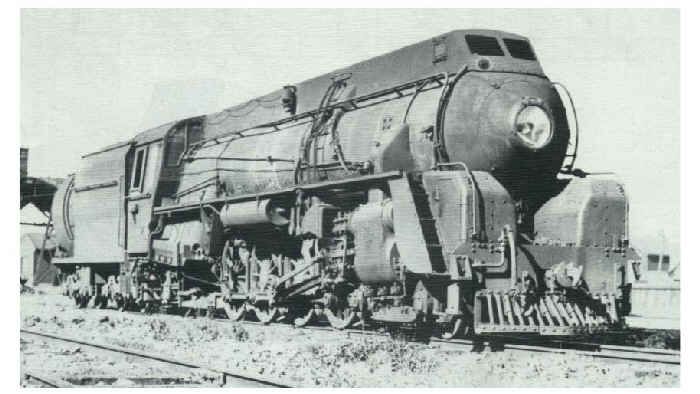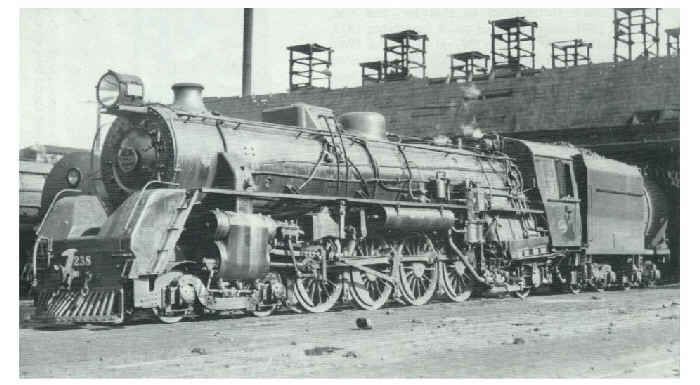Towards the end of March 2024, I stumbled across a number of journals of the New Zealand Model Railway Guild. One of these, the March 2021 edition, included a pictorial article about J1211 North British 4-8-2 Locomotive No. 24534 of 1939. [6] The June 2021 issue included a history of the class [7: p13-15] and General Arrangement plans as originally carried in the Railway Gazette in 1940. [7: p22-24] Also in that journal are four photographs of J1211 in service between 1960 and 1970. [8]
40 No 4-8-2 locomotives which were built in 1939 by the North British Locomotive Company and became the New Zealand Railways (NZR) J class.
They were designed to provide a mixed traffic locomotive suitable for running on the lighter secondary lines of the NZR network, and for express passenger trains in major routes.
“The J class incorporated roller bearing axles, hydrostatic lubrication and twin Westinghouse brake pumps. … They had bar frames instead of plate frames and were equipped with Baker Valve-gear. The locomotives were attached to Vanderbilt tenders and were outshopped with distinctive bullet-nosed streamlining.” [1] The streamlining also encompassed the full length of the top of the boiler between the cab and the smoke box door and the area immediately beneath the smoke box door.

New Zealand’s North Island benefitted from the first thirty of the class placed into service. The South Island hosted the remaining ten locomotives which apparently were used “The first 30 of the class in service were allocated to the North Island, with the remaining ten locomotives allocated to the South Island where they were used “on the hilly section between Dunedin and Oamaru. They were immediately placed into service on the main trunk routes in both islands in order to help move wartime traffic during the Second Word War. Although used on freight trains as well, the class was well suited to high-speed running on the passenger trains of the era.” [1]
Apparently, the streamlining became “burdensome for maintenance and the skyline casing, which was open at the top proved to be a trap for soot from the locomotive’s exhaust. After a time, the skyline casing started to be removed from some examples of the class leaving them with just the bullet nose.” [1]
Ultimately the bullet nose was also removed from the majority of these locomotives.

Members of the class “were generally considered to be a very reliable engine and well suited to their task. … They were capable of speeds of over 60 mph with a 300-ton express train. …. However, today surviving engines being used to haul excursion trains are restricted to 80 kph. … On favourable grades a single J could move a 1000-ton train.” [7: p14]
“The design was successful enough that NZR opted to build an improved variant … in its own Hillside workshops from 1946.” [1] These ‘Ja’ class locomotives were numbered 1240 to 1274 and became “the mainstay of the South Island rail services. Meanwhile North British were commissioned to build another 16, numbered from 1275 to 1290, also classified ‘Ja’, but they were oil fired and to be based in the North Island. … The sixteen ‘Ja’ from North British were the last steam locomotives to enter service with the NZR.” [7: p15]
Three J Class 4-8-2 are noted by Trainweb [2] as having been preserved:
J 1234, North British #24557/1939. For some time based at Glenbrook Vintage Railway, Auckland.. This locomotive is owned by Steam Incorporated of Paekakariki, and was leased to the Glenbrook Vintage Railway in 1998. The locomotive was returned to Paekakariki in June 2015. [4] It is now in storage awaiting a 2nd restoration at Paekakariki. [5]
J 1211 “Gloria”, North British #24534/1939. Mainline Steam Heritage Trust, Auckland (Operational). [3]
J 1236, North British #24559/1939. Mainline Steam Heritage Trust, Auckland (Being Restored). [2]
References
- https://preservedbritishsteamlocomotives.com/north-british-locomotive-comapany-works-no-24534-class-j-j-1211-gloria-4-8-2-new-zealand-railways, accessed on 26th March 2024.
- http://www.trainweb.org/nzsteam/j_4-8-2.html, accessed on 26th March 2024.
- https://www.mainlinesteam.co.nz/history, accessed on 26th March 2024.
- https://en.m.wikipedia.org/wiki/Glenbrook_Vintage_Railway, accessed on 26th March 2024.
- https://www.steaminc.org.nz/our-rail-fleet/steam-locomotives, accessed on 26th March 2024.
- 50’s Focus; NZ Model Railway Journal, Issue No. 413, March 2021, p14-15.
- North British 4-8-2 J Class Locomotive; NZ Railway Journal, Issue No. 414, June 2021.
- Sixties Style!; NZ Railway Journal, Issue No. 414, June 2021, p16-17.


IIRC the oilburners were classed Jb.Folklore is that the class touched 70 mph hauling South Island Ltd over the Canterbury Plains section, but I don’t know how often. Roderick Smith via Frank.
It’s a shame, Roger, that you feel the need to perpetuate this unfortunate myth, so widely and so persistently propagated by unthinking members of the railfan fraternity: “Unofficially they have been said to be capable of achieving speeds in excess of 90 mph…” It is indeed ‘unofficial’; it’s utterly anecdotal, and that’s worse. All mechanical aspects of these locomotives and the permanent way of the times mitigate completely against these and similar classes being able to attain anything other than 60+ mph to a very minor extent. I do wish people would just stop repeating this silliness. They had 54″ driving wheels/18 x 26″ piston stroke, with only 1,067 mm track gauge. Have you ANY notion al all of what the piston-stroke timing at 60 mph would have been (in excess of 7 strokes/second) and how rough the ride would have been? Even 70 mph is ludicrous! Please, Roger, just be one person who chooses not to maintain this fiction.
Noted and altered Fergus.
I have removed that element of the quote from the Journal.
I have to say, I appreciate that, Roger. All in the interests of historical accuracy… and these locomotives could never run that fast, for a variety of reasons. But railfans can be emotional creatures, and if they heard some old driver said “We were doing 70…”, they want it to be so. All the very best!
no disrespect but clearly you have not seen this for yourself, i have seen theses speeds on “j” and”k” class locos first hand. just because you don’t believe its possible doesn’t mean it has never happened.
Sorry Roger. You’re wrong, I’m an engineman. I HAVE seen it for myself! Many times. Like I explain in my dissertation, you may well have seen the ‘indicated’ speed any amount of times (on a non-certified device), but, well… I think I explain adequately why that doesn’t mean you were travelling at that speed. Like I say, this strange and persistent desire for many people to insist on something that is impossible, just because it excites and suits them to hold that view, is a really unfortunate factor in the context we are discussing. You started off by responding very positively and very reasonably when I first commented on your posting, but it seems your mind has been changed and your latest comment is unfortunate. Thanks anyway for engaging.
Hi Fergus, you have responded to a comment by someone else …’AH’
I have no idea who he/she is. I was happy to accept your comments. Kind regards
Roger